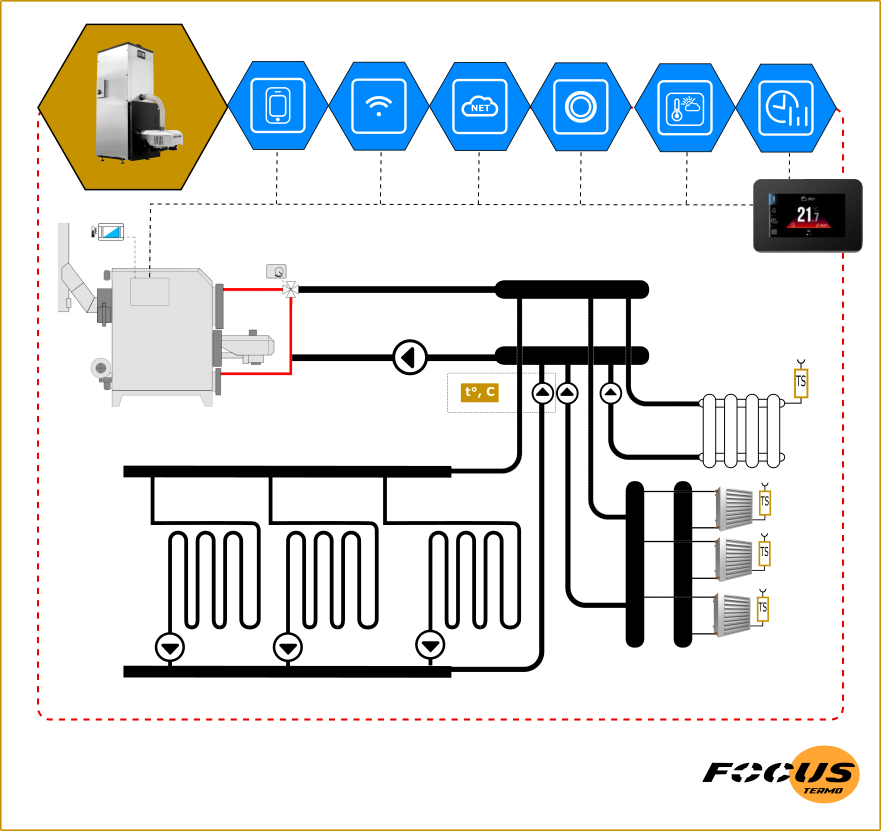Zoned heating Smart Home for the home using sensors with a program-controlled boiler FOCUS
Zone heating Smart Home using heating circuits allows you to achieve optimal comfort in every zone of your home, providing individual temperature control in each room and saving energy. We will tell you how to implement it and by what means in this article.
Smart Home heating for a small house
Smart Home heating for home by zones
To organize Smart Home zonal heating, separate circuits are installed in each zone of the house to provide heating for a specific zone. They can be independently controlled and adjusted. Here's how it's usually implemented:
- Various heating circuits in the boiler hydraulic circuit: Each zone or room in your home has its own heating circuit. This means that each zone uses a separate system of piping and radiators (or underfloor heating, air heaters), which can be independently controlled by sensors, remote devices or scripts.
- Using zone valves: To control the coolant flow, zone valves are installed in each circuit. These valves allow you to regulate the heat flow in each zone depending on the required temperature.
- Thermostat control: Separate thermostats are installed in each zone to control the temperature. Thermostats are usually connected to zone valves and regulate their operation depending on the set temperature in each zone.
- Automatic regulation: A zone heating system can be set to automatically adjust the temperature in each zone depending on the time of day, occupancy, and other factors. For example, the temperature can be lowered in sleeping areas during the night or when the room is unoccupied.


Smart Home zone heating: in addition to circuits, sensors and/or remote controls will be required
We have already talked about heating according to the Smart Home concept for a small house. Typically, this version uses electronic-mechanical activators and sensors that have little connection with each other. The more developed Smart Home concept implies unified system control. This becomes necessary when the power of the heating boiler in the heating circuit is regulated based on the need for heat consumption.
For this reason, Smart Home zonal heating is best implemented on the basis of boilers with a built-in weather controller, which allows you to deploy a complex smart heating system. That's exactly what they are pellet boilers FOCUS. The PLUM weather controller uses room temperature sensors and touch panels for setting scenarios to regulate the operation of the entire heating system.
Eventually…
Smart Home style zoned heating, controlled by sensors, is an efficient and convenient heating system that provides individual comfort in different areas of your home with the following features and devices:
Temperature sensors. Temperature sensors are installed in different areas of your home and measure the current temperature. They can be connected to a central Smart Home control system, which analyzes the received data.
Smart thermostats. Smart thermostats are installed in each zone, which regulate the operation of the heating system in accordance with data received from temperature sensors. In this way, thermostats can automatically control the temperature in each zone according to the set parameters.
Individual control. With zone heating, each family member can adjust the temperature in their room to the optimal level according to their preferences through touch screens, panels or remote controls. For example, you may be comfortable with a slightly warmer temperature than your child or guest.
Energy saving. Zone heating reduces energy costs because heating is activated only in those zones where it is needed. If certain rooms are not in use, the system automatically lowers the temperature in those areas, which helps save energy.
Remote control. Smart Home control systems usually provide the ability to control your heating remotely via a mobile app. This means you can adjust the temperature in each zone, even outside the home, using your smartphone or tablet.
Automation. In addition to manual touch controls, Smart Home systems can provide the ability to automatically adjust the temperature using a weather controller that supports heating scenarios depending on the time of day, the presence of people in the room, weather conditions and other factors.
Overall, Smart Home's sensor-controlled zone heating provides convenience, energy savings, and personalized comfort to your home by ensuring the optimal temperature in each zone.
